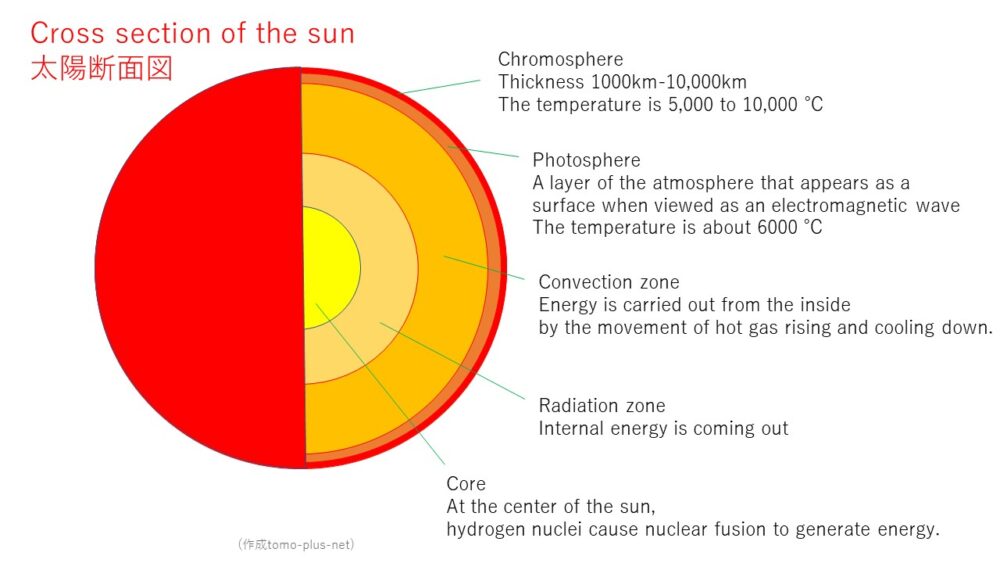What if I dive into the sun? I found a video called, so this time I would like to show off the knowledge I gained from it and the knowledge I researched myself.
First of all, how big the sun is, it is about 1.4 million km in diameter. In comparison, the size of the earth is 12,742km in diameter. The diameter of the sun is about 109 times that of the earth.
It is said that the radiation of the sun at a distance of 10 million km from the sun is more than 200 times that of the radiation received on the earth. From a distance of 7 to 10 million km from the sun, we will enter the corona of the sun.
The chromosphere is a part with a thickness of about 1,000 to 10,000 km sandwiched between the photosphere and the corona, and when the photosphere is covered with the moon during a total solar eclipse, it looks shining red. This red color is emitted by hydrogen and has a higher temperature than the photosphere, and is estimated to be about 10,000 degrees Celsius.
The large explosion that occurs in the chromosphere on the surface of the sun is called flare, which is the largest explosion phenomenon in the solar system. Small ones are said to wake up about three times a day.
Sunspots are areas where the temperature is lower than the surroundings because the lines of magnetic force gather on the surface of the sun and convection from the inside stops.
I remember the flares and sunspots that I learned at school. I’m quite a favorite genre, so I remember having a good test score.
Well, the temperature of the corona part is as high as 2 million degrees, but the temperature of the photosphere inside it is about 5500 degrees, which is low for some reason. The mystery of this difference in temperature seems to be an unsolved problem in physics. The prevailing theory is that it may be related to the magnetic force of the sun, but the details are unknown. But 5500 degrees is a ridiculously high temperature for us.
By the way, the gravity of the sun is about 28 times that of the earth. Hydrogen and helium, which are the constituents of the sun, are turned into plasma due to the influence of their gravity, and the density on the surface of the sun is less than 1/1000 of that of the earth’s atmosphere. The sun has nothing to call the ground, so even if it reaches the photosphere, it will pass through as it is.

This picture was drawn by me. I think it’s easy to understand, but what about it?
The photosphere is 300km to 500km, and there is a part called the convection zone inside it. Here, the hot ones are rising and the cold ones are falling. It is a layer where heat from the inside is constantly moving to the top. This lowest layer has a high temperature of up to 2 million degrees. And next is the radiative zone. The temperature exceeds 2 million degrees. The atmospheric pressure is said to be 100 million atmospheres.
And finally it is the core of the sun. Hydrogen is converted to helium by nuclear fusion, and it is a place that can be called the “fire pot” of the sun that emits light. The temperature here is 15 million degrees Celsius, which is said to exceed 200 billion atmospheres. At this pressure, the density is condensed, and the density in the center reaches about 150,000 kg / m 3.
You can’t understand it anymore. That’s right?
In this “furnace”, the sun consumes about 600 million tonnes of hydrogen per second (in seconds‼). This is about one million years of energy used by all humankind on Earth. This is emitted in the form of “light.” However, since this light passes through the condensed density in the sun, it scatters and travels while colliding with the atoms that are the constituents of the sun. Therefore, one theory is that it will take 170,000 years to reach the surface of the sun. Looking only at the size of the sun, it should reach in 2 seconds.
Based on this theory, the “light” of the sun we are receiving now is 170,000 years old.
Even if a large amount of hydrogen is converted to helium every day, it seems that it will continue to shine as it is for more than 5 billion years. It can be said that the sun, which was born about 4.6 billion years ago, is now in its mid-life.






